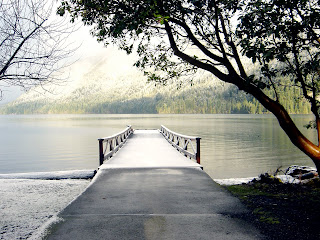
 As mentioned earlier, this was February. Lake Crescent Lodge was not fully open. Not even close. But you can reserve a cabin...and you should. The drive alone is worth the trip. Swiss Alps? Olympic National Park has it all.
As mentioned earlier, this was February. Lake Crescent Lodge was not fully open. Not even close. But you can reserve a cabin...and you should. The drive alone is worth the trip. Swiss Alps? Olympic National Park has it all. The peninsula is like a puzzle with the national park, forest, reservation and private land interconnected. We left Lake Quinault Lodge following Highway 101 towards the Pacific. We could have taken days for this trip, but I had to get to Port Angeles and Olympic National Park Headquarters to do research at the museum. Instead of stopping along the beach, we cut inland at Ruby Beach, drove through the Olympic National Forest to Port Angeles. By the time we headed back to Lake Crescent, it was mid-afternoon. Mist hung over the lake and the two-lane road clung to the shoreline. Mountain peaks rose straight from the shoreline. As we headed along the southern edge of the lake, we were the only car. Snow began to fall as the light dropped behind the mountains. I turned onto Barnes Road along the creek and followed the signs to the lodge. A meadow unfolded before us introducing us to a simple two-story, shingle Arts and Craft style lodge and cabins. It seemed that not only were we the lone guests, but the only people within miles.
We had made reservations for one of the Roosevelt Fireplace Cottages, the only accommodations open during our visit. The manager knew when we were coming, and had left instructions to pick up our key. The two-bedroom, knotty pine paneled cottage faced the lake. A huge picture window framed the view. It was cold, so I loaded the fireplace with kindling and logs, and, viola, lighted the fire without opening the flue. The windows were open to let out the smoke, the fire was burning nicely, but it looked like it could be a long night. The cabin had snacks and breakfast makings there, but the restaurant was closed. My friend, Deborah, had packed food and wine, so we made due with a picnic. After we ate, I got my flashlight and walked around the grounds anxious for the next day and discovering what had changed at the lodge since my last visit over twenty years ago. The ground was crunchy cold and the moon was out. I made my way to the dock, and looked across the lake. Steely cold grey of the lake and mountains merged into one. What a place, what a history. I could hardly wait for morning to shed new light on this place.
What morning brought was snow, and more snow. The manager met us and we began walking through the lodge. I had spent a good amount of time looking at historic photos of the 1915 lodge, and without guests in baseball hats and sweatshirts, it could well have been the those days when guests arrived via boat with the ladies in billowing skirts and the gentlemen dressed in coats and ties. The main lobby had changed little with much of the original furniture, patined wood paneling and original light fixtures and the huge Roosevelt elk head still holding court over the lodge. There is a cocktail lounge partitioned off in a corner. An odd arrangement, but it looks to work just fine. The multi-paned dining room that once held views of Mrs. Singer's gardens has been turned into a gift shop, and the dining room moved to a large room added in the 1950s with lake views. The crown jewel of the main level is the glassed in front sunporch full of wicker furniture and when the warm weather comes, baskets of geraniums. A corner stairway leads to restored second floor guest rooms with shared bath.
Here are my tips for staying at Lake Crescent Lodge:
- Stay in the Singer Tavern Cabins if you can. They were rebuilt just like the originals after it was decided that the old buildings simply could not be restored. I usually hate this, but these are charming and you can opt for one or two rooms.
- If you like things true to history, the five upstairs rooms are tiny and fun with a shared central bath.
- Families will enjoy the one or two bedroom Roosevelt Fireplace Cottages with fireplaces. Open the flues.
- The motel units offer lots of rooms, but not the charm of the Singer, main lodge or Roosevelt cottages.
- If you go off season when the restaurant is closed, bring plenty of food and drink. There is nothing close by.
- Enjoy the historic gardens, then take hikes. This is a terrific base for exploring the park.
- Swim in the lake if it is summer.
- The restaurant attracts guests and locals to the lodge, so make a reservation. This is second hand info, but I trust the sources.
- Walk over to the 1914 Rosemary Inn grounds. This historic "camp" is now run by the Olympic Park Institute. The tiny cabins are unique and fabulous.
- For more on the lodge, check out Great Lodges of the National Parks, Volume Two.
These photos were taken by Christine Barnes and do not appear in her books. (Not bad?)



